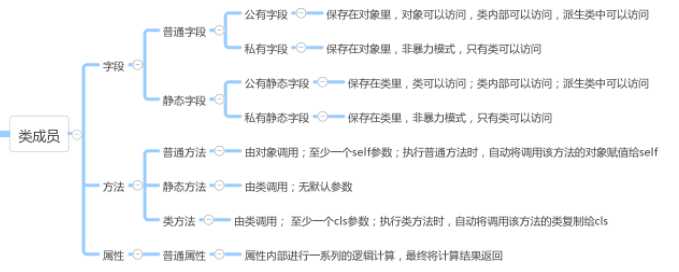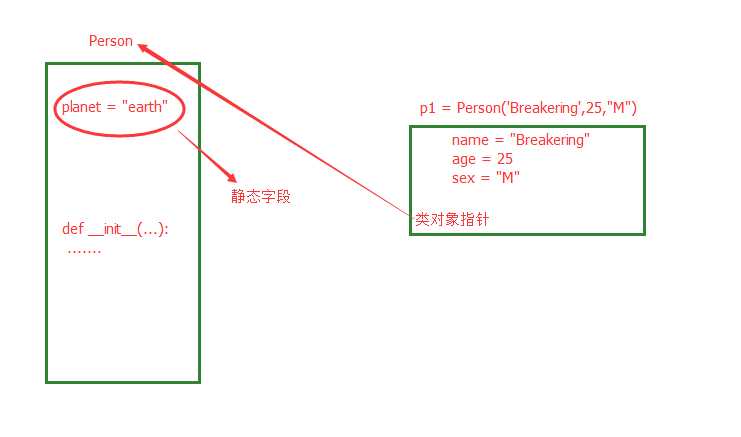标签:iter pos ict str 内部使用 数据 ffffff view code
类的成员可以分为三大类:字段、方法和属性

1 class Person(object): 2 3 planet = "earth" 4 5 def __init__(self, name, age, sex): 6 self.name = name 7 self.age = age 8 self.sex = sex 9 10 # 普通字段访问 11 p1 = Person("Breakering", 25, "M") 12 print(p1.name) 13 # ==>Breakering 14 # print(Person.name) # 普通字段是不能通过类来访问的 15 16 # 静态字段访问 17 print(Person.planet) 18 # ==>earth 19 print(p1.planet) # 可以通过对象来访问静态字段 20 # ==>earth 21 p1.planet = "mars" # 此时是在p1这个对象中重新创建了一个变量planet 22 print(p1.planet) 23 # ==>mars 24 print(Person.planet) # 类中的planet不会发生改变 25 # ==>earth 26 Person.planet = "mars" # 只能通过类来修改静态字段 27 print(Person.planet) 28 # ==>mars
由上述代码可以看出【普通字段需要通过对象来访问】【静态字段通过类访问】,在使用上可以看出普通字段和静态字段的归属是不同的。其在内容的存储方式类似如下图:

1 class Person(object): 2 3 _planet = "earth" 4 5 def __init__(self, name): 6 self.name = name 7 8 def talk(self): # 普通方法 9 print("%s is say Hello!" % self.name) 10 11 @classmethod 12 def get_planet(cls): # 类方法 13 return cls._planet 14 15 @staticmethod 16 def test(): 17 print("test") 18 19 # 调用普通方法 20 p1 = Person("Breakering") 21 p1.talk() 22 print(p1.get_planet()) # 对象可以调用类方法 23 p1.test() # 对象也可以调用静态方法 24 25 # 调用类方法 26 print(Person.get_planet()) 27 28 # 调用静态方法 29 Person.test() 30 31 Person.talk() # 类不可直接调用普通方法 32 # ==>TypeError: talk() missing 1 required positional argument: ‘self‘ 33 34 def f1(): 35 print("f1") 36 37 p1.f1 = f1 # 这时方法是保存在对象中的 38 39 p1.f1() 40 41 Person.f1() 42 # ==>AttributeError: type object ‘Person‘ has no attribute ‘f1‘
相同点:对于所有的方法而言,均属于类(非对象)中,所以,在内存中也只保存一份。
1 class Dog(object): 2 """ 这个类是描述狗这个对象的 """ 3 4 def __init__(self, name): 5 self.name = name 6 self.__food = "包子" 7 8 @property # attribute 9 def eat(self): 10 print("%s is eating %s" % (self.name, self.__food)) 11 return self.__food 12 13 d = Dog("flydog") 14 d.eat
属性的定义有两种方式:
1 class Dog(object): 2 """ 这个类是描述狗这个对象的 """ 3 4 def __init__(self, name): 5 self.name = name 6 self.__food = None 7 8 @property # attribute 9 def eat(self): 10 print("%s is eating %s" % (self.name, self.__food)) 11 return self.__food 12 13 @eat.setter 14 def eat(self, food): 15 print("set to food:", food) 16 self.__food = food 17 18 @eat.deleter 19 def eat(self): 20 del self.__food 21 print("删完了") 22 23 def talk(self): 24 print("%s is talking" % self.name) 25 26 d = Dog("flydog") 27 print(d) 28 d.eat = "包子" 29 d.eat 30 del d.eat
静态字段方式,创建值为property对象的静态字段
1 class Dog(object): 2 """ 这个类是描述狗这个对象的 """ 3 4 def __init__(self, name): 5 self.name = name 6 self.__food = None 7 8 def get_food(self): 9 print("%s is eating %s" % (self.name, self.__food)) 10 return self.__food 11 12 def set_food(self, food): 13 print("set to food:", food) 14 self.__food = food 15 16 def del_food(self): 17 del self.__food 18 print("删完了") 19 20 def talk(self): 21 print("%s is talking" % self.name) 22 23 FOOD = property(get_food, set_food, del_food, "食物属性描述") 24 25 d = Dog("flydog") 26 d.FOOD = "包子" 27 d.FOOD 28 del d.FOOD
property的构造方法中有个四个参数
对象.属性 时自动触发执行方法对象.属性 = XXX 时自动触发执行方法del 对象.属性 时自动触发执行方法对象.属性.__doc__ ,此参数是该属性的描述信息
类的所有成员在上一步骤中已经做了详细的介绍,对于每一个类的成员而言都有两种形式:
1 class Student(object): 2 3 def __init__(self, name, age, score): 4 self.name = name # 公有字段 5 self.__age = age # 私有字段 6 self.__score = score # 私有字段 7 8 def print_score(self): 9 print(‘%s: %s‘ % (self.name, self.__score))
__score,这样的实例变量外部是可以访问的,但是,按照约定俗成的规定,当你看到这样的变量时,意思就是,“虽然我可以被访问,但是,请把我视为私有变量,不要随意访问”。__score 因为Python解释器对外把变量__score改成了 _Student__score,所以,仍然可以通过_Student__score来访问__socre变量:__score改成不同的变量名。1 >>> bart = Student(‘Bart Simpson‘, 25, 98) 2 >>> bart.print_score() 3 Bart Simpson: 98 4 >>> bart.__score = 100 # 设置__score变量! 5 >>> bart.__score 6 100
__score变量,但实际上这个变量和__score class内部的__score变量不是一个变量!内部的__score变量已经被Python解释器自动改成了_Student__score,而外部代码给bart新增了一个__score变量。不信试试:1 >>> bart.print_score() 2 Bart Simpson: 98
1 class A(object): 2 a = "a" 3 __b = "b" 4 5 def __init__(self, name, sex): 6 self.name = name 7 self.__sex = sex 8 9 def get_a(self): 10 print(self.a) 11 12 def get_b(self): 13 print(self.__b) 14 15 class B(A): 16 17 def show_name(self): 18 print(self.name) 19 20 def show_sex(self): 21 print(self.__sex) 22 23 obj1 = A("Dog", "F") 24 obj2 = B("Wolf", "M") 25 print(obj1.a) # 对象可以访问公有静态字段 26 # print(obj1.__b) # 对象不可以访问私有静态字段 27 obj1.get_a() # 类内部可以访问公有静态字段 28 obj1.get_b() # 类内部可以访问私有静态字段 29 obj2.get_b() # 子类可以访问父类私有静态字段 30 obj2.show_name() # 子类可以访问父类的公有字段 31 print(obj2.a) # 子类可以访问父类的公有静态字段 32 # print(obj2.__b) # 子类不可以访问私有静态字段 33 print(obj2.name) # 子类可以访问公有字段 34 # obj2.show_sex() # 子类不能访问父类的私有字段
1 class Dog(object): 2 """ 这个类是描述狗这个对象的 """ 3 4 def __init__(self, name): 5 self.name = name 6 self.__food = None 7 d = Dog("flydog") 8 print(d.__doc__) 9 # ==> 这个类是描述狗这个对象的

1 class C: 2 3 def __init__(self): 4 self.name = ‘Breakering‘

1 from lib.aa import C 2 3 obj = C() 4 print obj.__module__ # 输出 lib.aa,即:输出模块 5 print obj.__class__ # 输出 lib.aa.C,即:输出类
1 class C: 2 3 def __init__(self): 4 self.name = ‘Breakering‘
1 class Foo: 2 3 def __del__(self): 4 # 关闭服务器 5 # 关闭进程 6 ...
1 class Foo: 2 3 def __init__(self): 4 pass 5 6 def __call__(self, *args, **kwargs): 7 8 print ‘__call__‘ 9 10 11 obj = Foo() # 执行 __init__ 12 obj() # 执行 __call__
1 class Person(object): 2 3 _planet = "earth" 4 5 def __init__(self, name): 6 self.name = name 7 8 def talk(self): # 普通方法 9 print("%s is say Hello!" % self.name) 10 11 @classmethod 12 def get_planet(cls): # 类方法 13 return cls._planet 14 15 @staticmethod 16 def test(): 17 print("test") 18 19 print(Person.__dict__) 20 # {‘talk‘: <function Person.talk at 0x0000020E50C23510>, ‘__init__‘: <function Person.__init__ at 0x0000020E50C23488>, ‘__dict__‘: <attribute ‘__dict__‘ of ‘Person‘ objects>, ‘__module__‘: ‘__main__‘, ‘__doc__‘: None, ‘test‘: <staticmethod object at 0x0000020E50C2C160>, ‘_planet‘: ‘earth‘, ‘__weakref__‘: <attribute ‘__weakref__‘ of ‘Person‘ objects>, ‘get_planet‘: <classmethod object at 0x0000020E50C2C128>} 21 22 print(p1.__dict__) 23 # {‘name‘: ‘Breakering‘}
1 class Foo: 2 3 def __str__(self): 4 return ‘Breakering‘ 5 6 7 obj = Foo() 8 print(obj) 9 # 输出:Breakering
但是细心的朋友会发现直接敲变量不用print,打印出来的实例还是不好看:
1 >>> obj 2 <__main__.Foo object at 0x109afb310>
__str__(),而是__repr__(),两者的区别是__str__()返回用户看到的字符串,而__repr__()返回程序开发者看到的字符串,也就是说,__repr__()是为调试服务的。__repr__()。但是通常__str__()和__repr__()代码都是一样的,所以,有个偷懒的写法:1 class Foo: 2 3 def __str__(self): 4 return ‘Breakering‘ 5 _repr__ = __str__

1 class Foo(object): 2 3 def __getitem__(self, key): 4 print ‘__getitem__‘,key 5 6 def __setitem__(self, key, value): 7 print ‘__setitem__‘,key,value 8 9 def __delitem__(self, key): 10 print ‘__delitem__‘,key 11 12 13 obj = Foo() 14 15 result = obj[‘k1‘] # 自动触发执行 __getitem__ 16 obj[‘k2‘] = ‘wupeiqi‘ # 自动触发执行 __setitem__ 17 del obj[‘k1‘] # 自动触发执行 __delitem__

1 class Foo(object): 2 3 def __getslice__(self, i, j): 4 print ‘__getslice__‘,i,j 5 6 def __setslice__(self, i, j, sequence): 7 print ‘__setslice__‘,i,j 8 9 def __delslice__(self, i, j): 10 print ‘__delslice__‘,i,j 11 12 obj = Foo() 13 14 obj[-1:1] # 自动触发执行 __getslice__ 15 obj[0:1] = [11,22,33,44] # 自动触发执行 __setslice__ 16 del obj[0:2] # 自动触发执行 __delslice__
1 class Foo(object): 2 3 def __init__(self, sq): 4 self.sq = sq 5 6 def __iter__(self): 7 return iter(self.sq) 8 9 obj = Foo([11,22,33,44]) 10 11 for i in obj: 12 print i
11. __new__ 和 __metaclass__
1 class Foo(object): 2 3 def __init__(self): 4 pass 5 6 obj = Foo() # obj是通过Foo类实例化的对象
1 print(type(obj)) # 输出:<class ‘__main__.Foo‘> 表示,obj 对象由Foo类创建 2 print(type(Foo)) # 输出:<type ‘type‘> 表示,Foo类对象由 type 类创建
obj对象是Foo类的一个实例,Foo类对象是 type 类的一个实例, 即:Foo类对象 是通过type类的构造方法创建。
那么,创建类就可以有两种方式:
a). 普通方式
1 class Foo(object): 2 3 def func(self): 4 print(‘hello‘)
b).特殊方式(type类的构造函数)
1 def func(self): 2 print(‘hello‘) 3 4 Foo = type(‘Foo‘,(object,), {‘func‘: func}) 5 #type第一个参数:类名 6 #type第二个参数:当前类的基类 7 #type第三个参数:类的成员
注:类是由type类实例化产生的
那么问题来了,类默认是由 type 类实例化产生,type类中如何实现的创建类?类又是如何创建对象?

标签:iter pos ict str 内部使用 数据 ffffff view code
原文地址:http://www.cnblogs.com/breakering/p/6883044.html